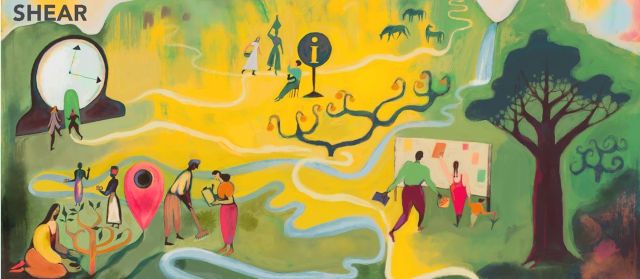Sharing lessons from SHEAR at EGU: challenges, innovations and research outcomes on forecasting and early warning
Since 2016, the SHEAR programme has been supporting improved disaster resilience and humanitarian responses by advancing the monitoring, assessment and prediction of natural hazards and risks across sub-Saharan Africa and South Asia. With the programme now coming to a close, SHEAR researchers shared a number of key research outcomes at this year’s European Geosciences Union (EGU) General Assembly, held in Vienna, Austria, and as an onsite event for the first time since 2019.
The findings presented by the SHEAR team covered several themes: landslide early warning; forecast-based early action; flood preparedness, monitoring and forecasting; impact-based forecasting; and supporting decision-making.

Landslide early warning
Members of the LANDSLIP team shared the main challenges and outcomes from their work in developing a prototype landslide early-warning system in India. This included their methodology for mapping landslide domains and an innovative hydrological model – the BGS water-balance model – that they used to develop hazard maps in a data-scarce context.
Also on this theme, the BOULDER team presented outcomes from their work investigating the use of smart sensors to understand hazardous debris flows and improve early-warning systems. Meanwhile members of the SHEAR Studentship Cohort presented findings from their research, including the use of serious games to develop skills and knowledge, and to inform actions, in relation to natural hazards, and how to use road proximity in landslide-susceptibility models.
Forecast-based early action
Forecast-based action enables institutional decision-makers to act in advance of weather and climate hazards, using forecasts to inform preparedness. The ForPAc project team presented the results of their research and pilot project work in Kenya to assess the skill of weather and climate models, and explored opportunities to scale forecast-based action across the Greater Horn of Africa.
Flood preparedness, monitoring and forecasting
The Landslide-EVO project developed an approach to estimate dynamic river discharge using non-contact, robust and cost-effective sensors. The team presented their findings about the effectiveness of this approach in monitoring the river stage and providing vital data about flood risk.
The FATHUM project worked with local stakeholders and end-users in Uganda to evaluate and understand the comparative suitability of a global hydrological forecasting and warning system (GloFAS) and a local catchment-based model (GR4J) as possible alternative or complementary flood-forecasting tools in Uganda. The team explored how community-led approaches can improve and strengthen early-warning systems to protect farmers and local communities from flood impacts, as well as the challenges and solutions of using forecasts to inform early action in anticipation of flood events.
Impact-based forecasting
The NFLICS team have been developing a prototype early-warning system and applying new nowcast products for impact-based forecasting in Senegal. They shared the results of their operational trials in 2020 and 2021, explaining how near-real-time satellite observations of land surface and convective clouds can be combined to provide up to 12 hours of early-warning lead time for flash floods. Also in this field, the SHEAR Impact and Integration project explored different perceptions and perspectives around impact-based forecasting, examining how to incorporate exposure and vulnerability data alongside hazard forecasts.
Supporting decision-making
The SHEAR project has worked with stakeholders at all levels and across many sectors to improve anticipatory capacities and decision-making processes, in order to enhance action in the face of future hazards. The team presented the lessons and best practices about both the content and process of developing early-warning information for institutional decision-makers, providing specific case studies and drawing on practical experience from SHEAR projects.
Collaborative governance was another theme explored, with a presentation about how far a shift to collaborative governance in Nepal has been able to strengthen disaster risk reduction (DRR), and the tension between top-down, state-led goals and local participation in DRR.
The COSMA team presented their findings on the role of human activity in buildings in affective energy consumption and anthropogenic heat, and ways to reduce this heat through building operations. The Connect4 Water Resilience project also presented their research outcomes at EGU 2022. This project brought together an international multidisciplinary team to investigate the drivers and impacts of floods and droughts, and to promote solutions towards adaptation. Their results are now being translated into tailored guidance for policy and practice in early warning and water resource management.
What has been achieved
The range of presentations delivered over the course of the week at EGU 2022 reflect what SHEAR has achieved through its collaborative, interdisciplinary, innovative research over the past few years. SHEAR projects have developed forecasting science to increase lead times, improve forecast skill and coverage, and incorporate impact information. The project teams have worked across contexts to improve datasets relating to landslides, floods, droughts and tropical storms. SHEAR has also developed tools to put this science into practice, linking research to impact by working with institutional stakeholders to improve the information and processes that inform decision-making.
As well as delivering these research outcomes, the SHEAR team also learned how to deliver research that is effective and impactful, particularly around putting stakeholder needs at the centre of research and interdisciplinary collaboration. The team will be sharing its latest and final knowledge and research outcomes from SHEAR over the next couple of weeks; in the meantime, you can read more about SHEAR’s impact around the world and the remaining challenges identified over the course of the programme.
This blog was written by the SHEAR Knowledge Broker.

